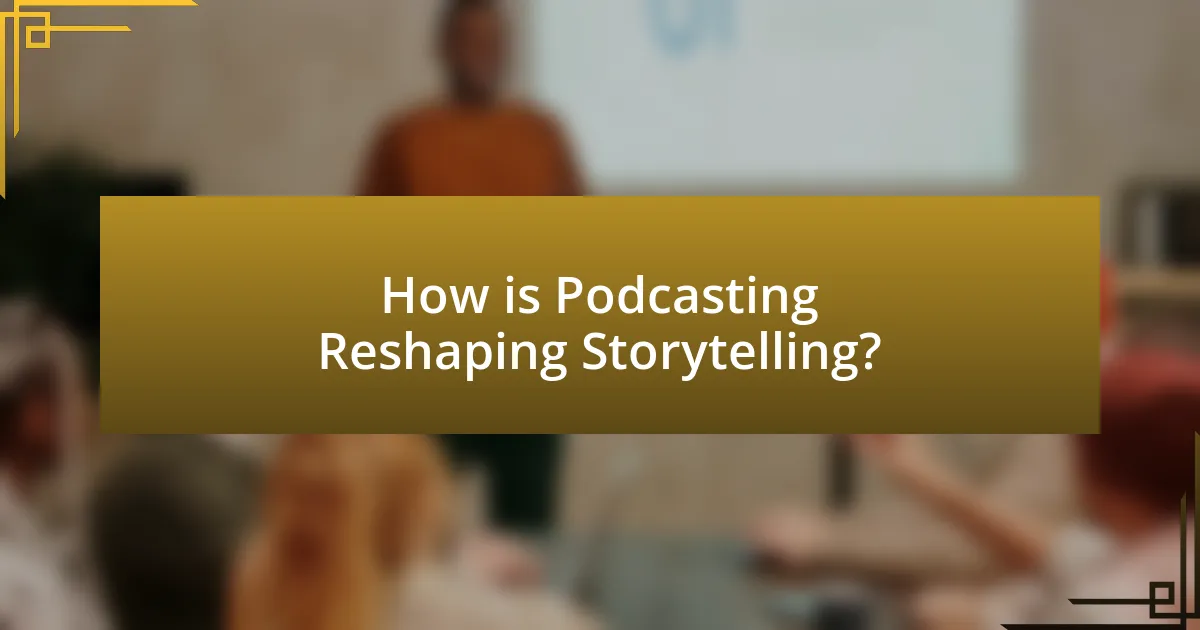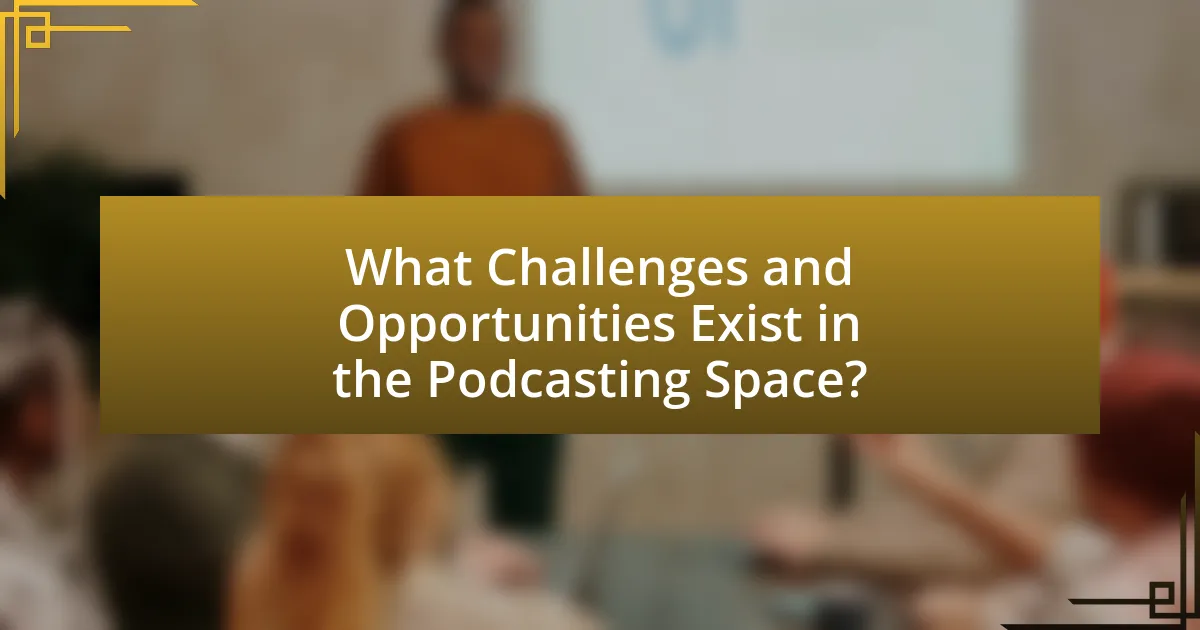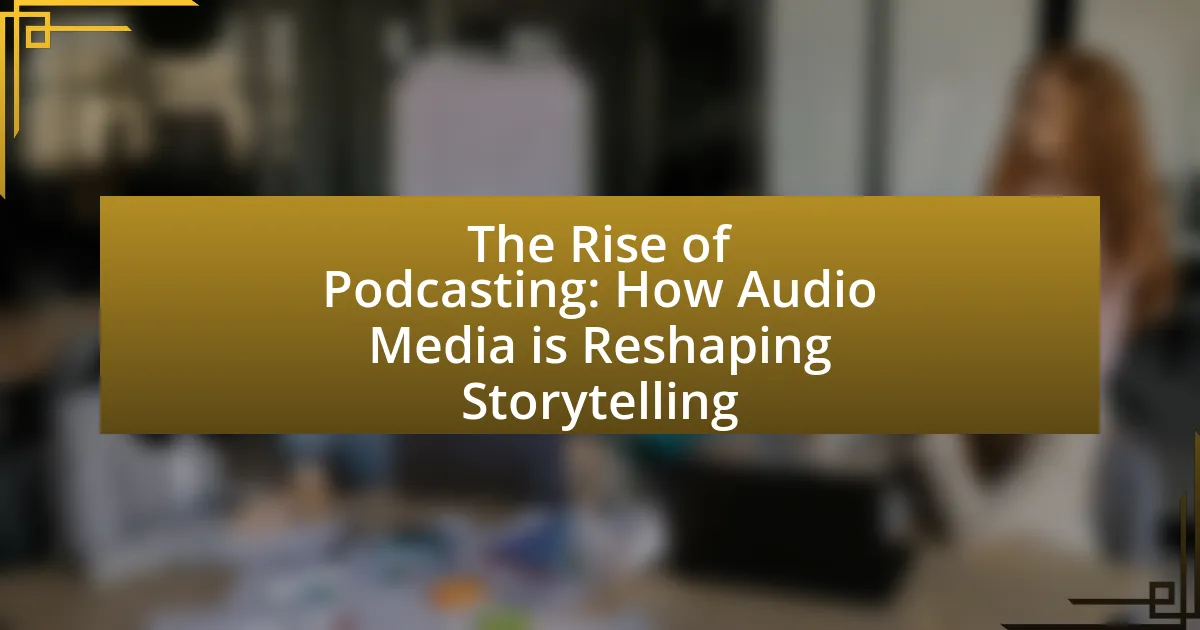Podcasting is a rapidly growing digital audio medium that allows users to create and share episodic content on various topics, with over 80 million Americans listening monthly as of 2023. The article explores the evolution of podcasting from a niche hobby to a mainstream platform, driven by technological advancements and changing audience behaviors. It highlights the importance of storytelling, production quality, and diverse voices in engaging listeners, while also addressing the challenges of market saturation and monetization faced by podcasters. Additionally, the article discusses the opportunities for content creators and brands to leverage podcasting for community building and marketing, emphasizing best practices for impactful podcast creation.

What is Podcasting and Why is it Gaining Popularity?
Podcasting is a digital audio medium that allows users to create, distribute, and listen to episodic content on various topics. Its popularity is increasing due to factors such as the rise of mobile technology, which enables on-the-go listening, and the growing demand for diverse content that caters to niche interests. According to Edison Research, as of 2023, over 80 million Americans listen to podcasts monthly, reflecting a significant increase in audience engagement and accessibility. This trend is further supported by the expansion of podcast platforms and the integration of podcasts into social media, making it easier for creators to reach wider audiences.
How has the podcasting landscape evolved over the years?
The podcasting landscape has evolved significantly from its inception in the early 2000s to a mainstream media platform today. Initially, podcasts were primarily produced by tech enthusiasts and niche creators, but by 2023, the medium has attracted major media companies and celebrities, leading to a diverse range of content. According to Edison Research, as of 2023, over 80 million Americans listen to podcasts monthly, indicating a substantial increase in audience engagement. The introduction of platforms like Spotify and Apple Podcasts has further democratized access, allowing creators to reach global audiences easily. Additionally, advancements in technology have improved audio quality and accessibility, making podcasting a viable medium for storytelling across various genres.
What technological advancements have contributed to the rise of podcasting?
Technological advancements such as the proliferation of high-speed internet, the development of portable audio recording devices, and the rise of user-friendly podcast hosting platforms have significantly contributed to the rise of podcasting. High-speed internet allows for seamless streaming and downloading of audio content, making it accessible to a wider audience. Portable audio recording devices, including smartphones, enable creators to produce high-quality audio content easily and affordably. Additionally, user-friendly podcast hosting platforms simplify the distribution process, allowing creators to reach listeners without needing extensive technical knowledge. These advancements have collectively facilitated the growth of the podcasting medium, evidenced by the increase in podcast production and consumption, with over 2 million podcasts available as of 2023.
How has audience behavior shifted towards audio media?
Audience behavior has shifted significantly towards audio media, with a marked increase in podcast consumption and audio streaming. According to Edison Research, as of 2023, 62% of Americans aged 12 and older reported listening to podcasts, up from 57% in 2022, indicating a growing trend in audio engagement. This shift is driven by the convenience of audio content, allowing listeners to multitask while consuming information, and the rise of mobile technology, which facilitates easy access to audio platforms. Additionally, the popularity of smart speakers has further integrated audio media into daily routines, reinforcing the trend of on-demand listening.
What are the key characteristics of successful podcasts?
Successful podcasts typically exhibit strong content quality, engaging storytelling, and consistent publishing schedules. High-quality content ensures that the information is valuable and relevant to the audience, while engaging storytelling captivates listeners and keeps them coming back for more. Consistent publishing schedules help build audience expectations and loyalty, as listeners know when to anticipate new episodes. According to a 2021 report by Edison Research, 75% of podcast listeners prefer shows that release episodes regularly, highlighting the importance of consistency in audience retention.
What role does storytelling play in engaging podcast audiences?
Storytelling plays a crucial role in engaging podcast audiences by creating emotional connections and enhancing listener retention. Engaging narratives captivate listeners, making them more likely to stay tuned and absorb the content. Research indicates that storytelling can increase information retention by up to 65% compared to facts alone, as it activates emotional responses and cognitive engagement. This emotional resonance fosters a sense of community among listeners, encouraging them to share episodes and participate in discussions, further amplifying audience engagement.
How do production quality and format influence listener retention?
Production quality and format significantly influence listener retention by enhancing the overall listening experience and engagement. High production quality, characterized by clear audio, professional editing, and well-structured content, keeps listeners attentive and reduces the likelihood of them dropping off. For instance, a study by Edison Research found that 80% of podcast listeners prefer shows with high audio quality, indicating that poor sound can lead to decreased retention. Additionally, the format of a podcast—whether it is narrative-driven, interview-based, or conversational—affects how well the content resonates with the audience. Research from the Podcast Host shows that episodic formats with consistent themes and storytelling elements lead to higher listener loyalty, as audiences are more likely to return for familiar and engaging content. Thus, both production quality and format are critical in maintaining listener interest and ensuring they continue to engage with the material.

How is Podcasting Reshaping Storytelling?
Podcasting is reshaping storytelling by providing a platform for diverse voices and narratives that traditional media often overlooks. This medium allows creators to engage audiences through intimate, serialized formats that foster deeper connections. According to Edison Research, as of 2023, 62% of Americans aged 12 and older have listened to a podcast, indicating a significant shift in how stories are consumed. The accessibility of podcasting enables storytellers to reach global audiences without the constraints of traditional publishing, thus democratizing content creation and allowing for innovative storytelling techniques.
What unique storytelling techniques are utilized in podcasts?
Podcasts utilize unique storytelling techniques such as immersive sound design, serialized narratives, and intimate interviews. Immersive sound design enhances the listening experience by incorporating ambient sounds and music, creating a vivid atmosphere that draws listeners in. Serialized narratives engage audiences over multiple episodes, allowing for deeper character development and plot complexity, as seen in popular series like “Serial.” Intimate interviews foster a personal connection between the host and guests, providing authenticity and emotional resonance, which is a hallmark of successful podcasts. These techniques collectively contribute to the distinctive storytelling landscape of audio media.
How do podcasts differ from traditional media in narrative style?
Podcasts differ from traditional media in narrative style primarily through their conversational tone and personal storytelling approach. Unlike traditional media, which often employs a more formal and structured narrative, podcasts frequently utilize informal dialogue, allowing hosts to engage listeners in a relatable manner. This style fosters intimacy and connection, as evidenced by the popularity of narrative-driven podcasts like “Serial,” which combines storytelling with investigative journalism, creating a unique listening experience that traditional media formats struggle to replicate.
What impact does audio storytelling have on emotional engagement?
Audio storytelling significantly enhances emotional engagement by utilizing voice modulation, sound effects, and music to create immersive experiences. Research indicates that listeners often experience heightened emotional responses when narratives are delivered through audio, as the human voice conveys nuances of emotion that text cannot replicate. A study published in the journal “Psychological Science” found that participants reported stronger emotional reactions to stories told in audio format compared to written formats, highlighting the effectiveness of audio in fostering empathy and connection. This emotional resonance is further amplified by the personal and intimate nature of listening, which allows audiences to form deeper connections with the characters and narratives presented.
Why are diverse voices important in podcasting?
Diverse voices are important in podcasting because they enhance representation and foster inclusivity, allowing a broader range of perspectives and experiences to be shared. This diversity enriches content, making it more relatable and engaging for various audiences. According to a 2021 report by Edison Research, podcasts featuring diverse hosts attract a wider listener base, demonstrating that audiences are drawn to varied narratives that reflect their own experiences or introduce them to new viewpoints. Furthermore, diverse voices can challenge dominant narratives and promote social change, as seen in podcasts that address issues of race, gender, and identity, thereby contributing to a more equitable media landscape.
How does representation in podcasting enhance storytelling?
Representation in podcasting enhances storytelling by providing diverse perspectives that resonate with a broader audience. When podcasters include voices from various backgrounds, cultures, and experiences, they create narratives that reflect the complexity of real life, making stories more relatable and engaging. Research indicates that diverse representation in media leads to increased audience connection and empathy, as highlighted in the 2020 report by the Annenberg Inclusion Initiative, which found that inclusive storytelling fosters a deeper understanding of different societal issues. This enriched narrative landscape not only captivates listeners but also encourages underrepresented groups to share their stories, further diversifying the podcasting medium.
What are the benefits of including varied perspectives in audio narratives?
Including varied perspectives in audio narratives enhances the richness and depth of storytelling. This diversity allows for a more comprehensive understanding of the subject matter, as different viewpoints can illuminate various aspects of a story that a single perspective might overlook. Research indicates that narratives incorporating multiple voices can foster empathy and connection among listeners, as they are exposed to experiences and opinions outside their own. For instance, a study published in the journal “Communication Research” found that audiences who engage with diverse narratives demonstrate increased openness to differing viewpoints, which can lead to greater social cohesion and understanding. Thus, the inclusion of varied perspectives not only enriches the narrative but also promotes broader societal benefits.

What Challenges and Opportunities Exist in the Podcasting Space?
The podcasting space faces challenges such as market saturation and monetization difficulties, while also presenting opportunities like niche audience engagement and innovative content formats. Market saturation is evident as over 2 million podcasts exist, making it challenging for new entrants to gain visibility. Monetization remains a hurdle, with only 10% of podcasters generating significant revenue, often due to reliance on advertising that can be inconsistent. Conversely, opportunities arise from the ability to target specific demographics, allowing creators to build loyal listener bases. Additionally, advancements in technology enable diverse content formats, such as interactive podcasts, enhancing listener engagement and expanding creative possibilities.
What are the common challenges faced by podcasters today?
Podcasters today commonly face challenges such as audience growth, monetization, content saturation, and technical issues. Audience growth is hindered by the vast number of podcasts available, making it difficult for new shows to stand out. Monetization remains a challenge as many podcasters struggle to secure sponsorships or generate revenue through listener support. Content saturation leads to competition, where unique ideas are harder to find, and podcasters must constantly innovate to retain listener interest. Additionally, technical issues, including sound quality and editing, can impede the production process and affect the overall listening experience. These challenges are supported by industry reports indicating that over 2 million podcasts exist, highlighting the competitive landscape, and surveys showing that less than 20% of podcasters earn significant income from their shows.
How can podcasters overcome issues related to monetization?
Podcasters can overcome issues related to monetization by diversifying their revenue streams. This includes utilizing sponsorships, listener donations, merchandise sales, and premium content subscriptions. For instance, a study by Edison Research in 2021 indicated that 41% of podcast listeners are willing to support their favorite shows financially, highlighting the potential of listener donations through platforms like Patreon. Additionally, podcasters can leverage affiliate marketing, where they earn commissions by promoting products relevant to their audience, further enhancing their income potential. By implementing these strategies, podcasters can create a sustainable financial model that mitigates the challenges of monetization.
What strategies can be employed to grow an audience effectively?
To grow an audience effectively, content creators should focus on consistent quality, targeted marketing, and audience engagement. Consistent quality ensures that listeners receive valuable and engaging content, which fosters loyalty and encourages word-of-mouth promotion. Targeted marketing involves identifying and reaching specific demographics through social media, email campaigns, and collaborations with influencers, which can significantly expand reach. Audience engagement, through interactive elements like Q&A sessions or feedback solicitation, builds a community around the content, enhancing listener retention and attracting new audience members. According to a 2021 report by Edison Research, 41% of podcast listeners discover new shows through recommendations, highlighting the importance of quality content and audience interaction in audience growth.
What opportunities does podcasting present for content creators?
Podcasting presents significant opportunities for content creators by enabling them to reach diverse audiences, establish authority in their niche, and monetize their content. The medium allows creators to share their expertise and stories in an engaging format, fostering a deeper connection with listeners. According to Edison Research, 55% of the U.S. population has listened to a podcast, indicating a growing audience base. Additionally, platforms like Patreon and sponsorships provide avenues for monetization, with the podcasting industry projected to reach $1 billion in ad revenue by 2024, demonstrating the financial potential for creators.
How can brands leverage podcasting for marketing purposes?
Brands can leverage podcasting for marketing purposes by creating engaging content that resonates with their target audience. This approach allows brands to build a loyal listener base, enhance brand awareness, and establish authority in their industry. According to Edison Research, 41% of Americans aged 12 and older have listened to a podcast in the past month, indicating a significant and growing audience. By integrating storytelling into their podcasts, brands can effectively communicate their values and connect emotionally with listeners, which can lead to increased customer loyalty and conversions. Additionally, brands can utilize sponsorships and partnerships within popular podcasts to reach wider audiences, as 61% of podcast listeners have reported being more likely to purchase from brands that sponsor their favorite shows.
What role does podcasting play in building community and connection?
Podcasting plays a significant role in building community and connection by providing a platform for shared experiences and discussions among listeners. This medium fosters intimacy through storytelling, allowing hosts to create a personal bond with their audience, which can lead to a sense of belonging. According to a 2021 report by Edison Research, 54% of podcast listeners feel a personal connection to the hosts, indicating that podcasts can effectively cultivate community ties. Additionally, podcasts often encourage listener engagement through social media and community forums, further enhancing connections among listeners who share similar interests or values.
What are the best practices for creating impactful podcasts?
To create impactful podcasts, focus on high-quality content, engaging storytelling, and effective promotion. High-quality content involves thorough research and clear messaging, ensuring that the information presented is accurate and relevant to the audience. Engaging storytelling captivates listeners, utilizing techniques such as narrative arcs and emotional connections to maintain interest. Effective promotion includes leveraging social media, collaborating with other podcasters, and optimizing for search engines to reach a broader audience. According to a 2021 report by Edison Research, 41% of Americans aged 12 and older have listened to a podcast in the past month, highlighting the growing popularity and potential reach of well-crafted podcasts.
How can podcasters enhance their storytelling techniques?
Podcasters can enhance their storytelling techniques by incorporating narrative structures, character development, and immersive sound design. Utilizing a clear narrative arc, such as the classic three-act structure, helps maintain listener engagement and provides a satisfying progression. Character development allows listeners to connect emotionally, making the story more relatable and impactful. Additionally, immersive sound design, including background music and sound effects, creates an atmosphere that enhances the storytelling experience. Research indicates that effective soundscapes can increase listener retention and emotional response, as demonstrated in studies by the University of Southern California, which found that audio storytelling with rich sound design significantly improves audience engagement.
What tools and resources are essential for aspiring podcasters?
Essential tools and resources for aspiring podcasters include a quality microphone, audio editing software, and a reliable hosting platform. A quality microphone, such as the Audio-Technica ATR2100x or the Shure SM7B, ensures clear audio capture, which is crucial for listener engagement. Audio editing software like Audacity or Adobe Audition allows podcasters to edit their recordings for clarity and professionalism. Additionally, a hosting platform such as Libsyn or Podbean is necessary for distributing episodes to various podcast directories, ensuring accessibility for listeners. These tools collectively enhance the production quality and reach of a podcast, which are vital for success in the competitive podcasting landscape.

Leave a Reply